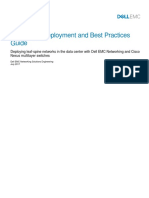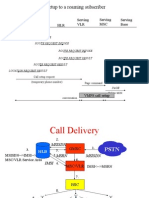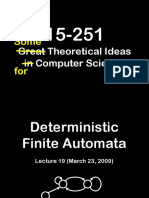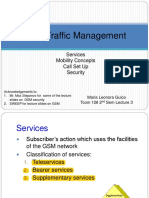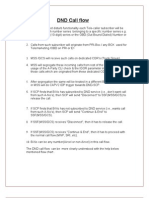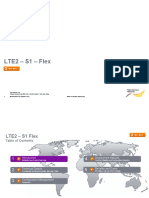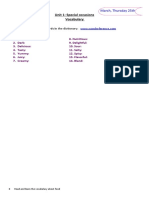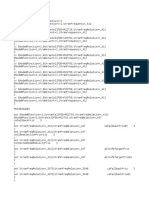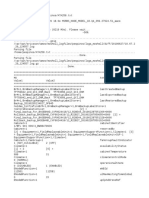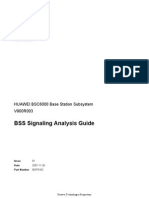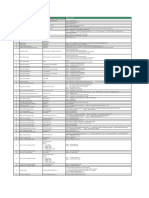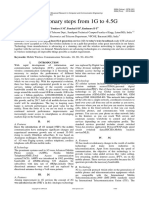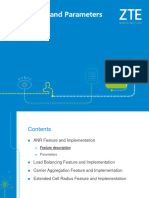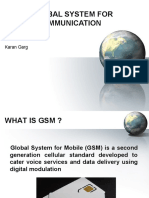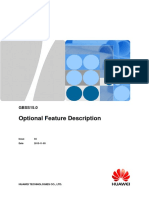EPS Overview
E-UTRAN + EPC = EPS (Evolved Packet System) E-UTRAN: Evolved RAN EPC: Evolved CN for E-UTRAN, UTRAN/GERAN and non-3GPP access
Signalling / Control Plane (GSM/UMTS/EPS) Traffic/ User Plane (GSM/UMTS/EPS)
23.401 (23.402) 36.300
Not really part of EPS
CS Domain TDMA GERAN
BTS NB MSC GMSC
PSTN/ GSM/UMTS
W-CDMA
BSC RNC UTRAN
Iu/Gb
SGSN
GGSN
PS Domain
PDP Context
Mobility Security (e.g. Authentication) Bearer Mgmt
Co-located with PGW? Same? Subscriber database Provides QoS and charging rules
Mobility between E-UTRAN and GERAN/UTRAN supported
VPLMN
HPLMN
OFDM downlink SC-FDMA uplink
eNB
Radio Base Station Radio Resource Mgmt
MME EPS Bearer SGW
HSS PCRF
PDN Packet Data Network IMS / Internet
PGW
UE
IETF mobility solutions supported
E-UTRAN
QoS aware packet routing UP anchor:E-UTRAN 2G / 3G
EPC
QoS aware packet routing User IP-address allocation Policy Enforcement Point
Non-3GPP IP-access WLAN WiMAX cdma 2000
System Characteristics e.g.
- simplified all-IP network architecture - everything over IP, also real-time services like voice - peak DL data rates min 100 Mb/s - System bandwidth: 1,4 up to 20 MHz - many possible frequency bands (todays GSM, UMTS, others) - same Core Network for many RANs - Service continuity to CS domain - Support for fixed, nomadic and mobile terminals
3GPP BSC CP CN CS DL eNB EPC EPS E-UTRAN FDMA FFS GERAN GGSN HSS HPLMN IETF IMS LA LTE MIP MME MS MSC 3rd Generation Partnership Project Base Station Controller Control Plane Core Network Circuit Switched Downlink Evolved NodeB Evolved Packet Core Evolved Packet System Evolved UTRAN Frequency Division Multiple Access For Further Study GSM/EDGE Radio Access Network Gateway GPRS Support Node Home Subscriber Server Home PLMN Internet Engineering Task Force IP Multimedia Subsystem Location Area Long Term Evolution Mobile IP Mobility Management Entity Mobile Station Mobile Services Switching Centre NB OFDM PDN PCRF PGW PLMN PS PSTN QoS RA RAN RAT RNC SAE SC-FDMA SGSN SGW TA TDMA UE UL UP UTRAN VPLMN NodeB Orthogonal Frequency Division Multiplexing Packet Data Network Policy and Charging Rules Function Packet Data Network Gateway Public Land Mobile Network Packet Switched Public Switched Telephone Network Quality of Service Routing Area Radio Access Network Radio Access Technology Radio Network Controller System Architecture Evolution Single Carrier FDMA Serving GPRS Support Node Serving Gateway Tracking Area Time Division Multiple Access User Equipment Uplink User Plane Universal Terrestrial Radio Access Network Visited PLMN
LEO_SF_01_100601
�E-UTRAN properties Shared channels only TTI = 1 ms QPSK, 16QAM, 64QAM MIMO (2 or 4 antennas) System Bw: 1.4, 3, 5, 10, 15, 20 MHz Both FDD and TDD modes
E-UTRAN
36.300, 36.xxx
Theoretical max: 325 Mb/s DL 85 Mb/s UL
eNB MME
For femtocells Self-organizing node Closed Subscriber Groups (CSG) Mobility with macro-layer Owned by subscriber / company Remote operator control (power, QoS, status)
R
eNB
IP Backbone Network IP Cloud
R
SGW
Radio Tx and Rx
Radio Resource Management (RRM) Handover decisions and execution
eNB self-optimization
Use UE measurements to: - optimize neighbour lists - optimize handover algorithms Home eNB
OFDM
eNB
EPC
MME UE context:
MME
SC - FDMA Handover management Load / Interference control Auto-configuration of: - X2-connections - neighbour relations
X2-C
S1-MME X2-U User data forwarding at handover
- UE ctx setup - Bearer mgmt - Handovers - Paging S11
Signalling Radio Bearers (SRB) Data Radio Bearers (DRB) Connected UE UE Identities: USIM id: IMSI EPC id: GUTI E-UTRAN id: RNTI Appl id: IP-address S1-U
eNB
SGW UE context:
SGW
PGW
S5/8 S1 Tunnel eNB UE context: UE Identity (RNTI+S1AP UE id)) UE Capabilities MME IP-address SGW IP-address & TEID QoS for bearers
EPS Bearer = Radio Bearer + S1 Tunnel + S5/8 Tunnel
AS CP C-RNTI CN Ctx DL eNB EPC EPS E-UTRAN FDD GUTI IMSI MME OFDM PGW Access Stratum Control Plane Cell Radio Network Temporary Identity Core Network Context Downlink Evolved NodeB Evolved Packet Core Evolved Packet System Evolved UTRAN Frequency Division Duplex Globally Unique Temporary Identity International Mobile Subscriber Identity Mobility Management Entity Orthogonal Frequency Division Multiplexing Packet Data Network Gateway QAM QoS QPSK R RAN RNTI S1-AP SC-FDMA SGW TDD TEID TTI UE UL UP USIM Quadrature Amplitude Modulation Quality of Service Quadrature Phase Shift Keying Router Radio Access Network Radio Network Temporary Identity S1 Application Protocol Single Carrier FDMA Serving Gateway Time Division Duplex Tunnel Endpoint Identifier Transmission Time Interval User Equipment Uplink User Plane Universal SIM
LEO_SF_02_100601
�OFDM Basics
for E-UTRAN
N =72 for 1,4 MHz N= 1200 for 20 MHz N Subcarriers OFDM symbols Rate = 1 / T
Transmission Side Tx eNB
Time Domain
Reception Side Rx UE
OFDM symbols
Modulation Symbols Rate = N / T
RF Bw loss: 3-25% [LTE: 6.7-20%]
E-UTRAN carrier
RF
E-UTRAN carrier
aN
S ,a2 ,a1 P
From coding & modulation [LTE: Turbo, QPSK/QAM]
I F F T
Add CP
TCP T CP OFDM
CP
OFDM
Remove CP
F F T
aN , ,a2 ,a1
To de-coding -modulation
OFDM Signal Creation (IFFT)
OFDM Signal Detection (FFT) Frequency Domain Sub-carrier spacing = f = 1 T
a1 f1 a2 .. aN fN f2
A1
A2 One OFDM symbol
Each symbol contains all subcarriers
a1 f1
OFDM
a2
.. f2
..
AN
aN
Sampled at centre, where other signals = 0
fN over k paths
Multipath Input to FFT FFT input window
FFT integrates energy
Modulation symbols Change amplitude & phase of subcarriers
+ + + -
OFDM Characteristics: Robust against frequency selective (multipath) fading Robust against inter-symbol interference Allows high spectral efficiency (due to fq-dependent scheduling) Sensitive to Doppler shift & frequency synch errors High PAPR (inefficient power usage)
Path 1 CP OFDM Path k Path m
CP FDMA FFT IFFT OFDM P/S PAPR Cyclic Prefix Frequency Division Multiple Access Fast Fourier Transform Inverse Fast Fourier Transform Orthogonal Frequency Division Multiplexing Parallell to Serial Peak to Average Power Ratio QAM QPSK RF SC-FDMA S/P UE UP Quadrature Amplitude Modulation Quadrature Phase Shift Keying Radio Frequency Single Carrier FDMA Serial to Parallell User Equipment User Plane
LEO_SF_03_100601
�UE
MME eNB
E-UTRAN Layer 2 and 3
PDCP: 36.323 RLC: 36.322 MAC: 36.321
NAS: 24.301 RRC: 36.331
NAS Control Plane RRC PDCP RLC MAC PHY
Uu
NAS S1AP SCTP IP L1/L2
S1-MME
RRC PDCP RLC MAC PHY
S1AP SCTP IP L1/L2
Layer 2 Protocols
reliable transport of L3 signalling/user data resource optimization security functions
Layer 3 Protocols
EMM: mobility & security procedures ESM: default & dedicated bearer mgmt RRC: radio related signalling
= NAS
UE
SGW eNB
IP User Plane PDCP RLC MAC PHY
Uu
PDCP GTP-U RLC MAC PHY UDP IP L1/L2
S1-U
GTP-U UDP IP PHY
Layer 3 Signalling: Incoming data to Idle UE
Ciph & integrity by PDCP Has Default Bearer ECM Idle RRC Idle RRC Signalling
UE
NAS Signalling Ciphering & integrity check by NAS
MME
Layer 2 Functions
CP (RRC) UP (IP)
System Information
DL Data Notification
Paging Random Access RRC Connection Establishment Paging from SGW
PDCP:
Integrity check Ciphering
Header Compression Ciphering
RLC Modes: Acknowledged Un-acknowledged Transparent SRB 1 configured
PDCP PDUs RLC:
S1AP carries NAS msgs
Segmentation/ concatenation Re-Tx (ARQ)
RLC PDUs
EMM: Service Request
RRC carries NAS msgs RRC Connection Reconfiguration EMM: Authentication Initial Context Setup
MAC:
Scheduling Multiplexing Re-Tx (HARQ)
Transport Blocks
Prioritisation: Signalling vs data Data vs data Select Transport Format (bits per Transport Block) Adding protection (extra bits)
DRB configured
User Data on Default Bearer (On Data Radio Bearer) (In S1-Tunnel)
RRC Connection Reconfiguration Measurement Report
Channel coding PHY (L1): Modulation OFDM
eNB instructs UE to measure and report Periodic or Event triggered
LEO_SF_04_100601
AM ARQ CP EMM ESM E-RAB HARQ MAC MME NAS PDU DRB PHY
Acknowledged Mode Automatic Repeat Request Control Plane EPS Mobility Management EPS Session Management EPS Radio Access Bearer Hybrid ARQ Medium Access Control Mobility Management Entity Non Access Stratum Protocol Data Unit Data Radio Bearer The Physical Layer
PDCP QoS RLC ROHC RRC RRM S1 AP SCTP SRB SGW TM UM UP
Packet Data Convergence Protocol Quality of Service Radio Link Control Robust Header Compression Radio Resouce Control Radio Resource Management S1 Application Protocol Stream Control Transport Protocol Signalling Radio Bearer Serving Gateway Transparent Mode Unacknowledged Mode User Plane
�E-UTRAN Physical Channels
RRC RLC MAC PHY IP
Downlink
PBCH: System Info PDSCH: Paging RRC Signalling User Data Sys Info PDCCH: Scheduling Assignments PCFICH: Size of PDCCH PHICH: ACK/NACK for UL Data
eNB RRC PDCP RLC MAC PHY
Physical Channels:
Mapped into frequency/time grid!
Fq Domain: 72 1200 Sub-Carriers One PRB: 12 subcarriers 0,5 ms
PDCP
RRC RLC MAC PHY
IP
PDCP
RRC RLC MAC PHY
IP
PDCP
Time Domain: OFDM symbols, subframe (1 ms) radioframe (10 ms)
Physical Signals
a set of resource elements not carrying information from higher layers Downlink: Reference Signals (RS) known by UEs, for channel estimation Synchronization Signals (SS) slot and frame synch + cell id
RRC PDCP RLC
RRC RLC MAC PHY
IP
Uplink
PRACH: Random Access
PDCP
PUSCH; RRC Signalling User Data
RRC RLC MAC PHY IP PDCP
MAC PHY
eNB
PUCCH: Scheduling Requests, ACK/NACK for DL data
eNB
Uplink: Demodulation Reference Signals UE specific (based on RNTI) Sent as part of PUSCH/PUCCH Sounding Reference Signal UE specific (based on RNTI) used by eNB to schedule UL PRB:s
LEO_SF_05.1_100601
MAC PBCH PDCCH PCFICH PDCP PDSCH PHICH
Medium Access Control Physical Broadcast Channel Physical Downlink Control Channel Phisical Control Format Indication Channel Packet Data Convergence Protocol Physical Downlink Shared Channel Physical Hybrid ARQ Channel
PRACH PRB PUSCH PUCCH RLC RRC TTI
Physical Random Access Indication Channel Physical Resource Block Physical Uplink Shared Channel Physical Uplink Control Channel Radio Link Control Radio Resource Control Transmission Time Interval
�Quality variations: short term (due to e.g. fading) long term (due to e.g location)
Quality (for resource block x)
Radio Resource Sharing
Downlink
Other short / long term quality variation pattern Closer to eNB Better average quality
Y
time
Scheduling Function in eNB priority between Log Ch for one UE (contol, data, RT/NRT, buffers etc) modulation & coding selected (HARQ for error free delivery) priority between all UEs physical resource blocks (PRBs) allocated to users per TTI implementation dependent, but UE interaction standardized
Downlink Allocation (PDCCH)
Quality (at time=t)
Resource block
User Data and Reference Signal (PDSCH) ACK/NACK and CQI Reports (PUCCH)
Data buffered in eNB
Data for X
eNB
fq
Data for Y Data for Z
Note: if UE moves at high speed CQI feedback gets outdated
Web browsing Non real-time non GBR
VoIP real-time GBR
DL output power is constant
UPLINK
eNB to eNB interference control/coordination using X2
eNB
Scheduling Principles: Round Robin: x, y, z, x, y, z, -> not maximized throughput Max C/I: schedule user with best channel -> max throughput, but unfair Proportional /Fair: short term channel quality exploted, butmaintaining long term user data rate LWDF: like P/F bt adding priority and delay for packet in buffer
12 Sub-Carriers
Scheduling Request (PUCCH or PUSCH) with Buffer Status Report
Data in UE
Sounding Reference Signal* (L1)
Uplink Grant (MAC) (PDCCH) User Data and Demodulation Ref. Signal(PUSCH) ACK/NACK (PHICH)
eNB
Note 1: Scheduling may depend on if cell is loaded or unloaded Note 2: Persistent Scheduling possible: UE gets re-occuring resource (e.g. for real time service)
BSR DRX DTX C/I CQI GBR LWDF HARQ MAC PHR PRB QoS SR TTI Buffer Status Report Discontinous Reception Discontinous Transmission Carrier to Interference Channel Quality Indicator Guaranteed bit rate Largest Weighted Delay First Hybrid Automatic Repeat Request Medium Access Control Power Headroom Report Physical Resource Block Quality of Service Scheduling Request Transmission Time Interval
UE output power may be limiting factor
eNB does not have full info on buffers in UE:s delay between UL request and actual Tx SC-FDMA -> adjacent resource blocks used *) requested by eNB, sent over larger bandwidth
One Sub-Frame (1 ms)
LEO_SF_05.2_100601
�Coverage Scenario
UTRAN/GERAN E-UTRAN
WLAN WLAN
EPC the Evolved Packet Core
23.401 (23.402)
E-UTRAN CS Domain MSC S4 SGSN (Rel 8+): Sometimes considered to be part of EPC SGSN Mobility mgmnt Security (EPS AKA) Bearer Mgmnt Selects SGW & PGW Stores UE Context S3 S6d
Signalling / Control Plane (GPRS/UMTS/EPS) Traffic/ User Plane
Possible Implementations
SGW PGW Combined GW
GERAN
BTS NB
BSC RNC UTRAN
Iu/Gb
MME SGW PGW
S4
Inter-RAT Mobility: TA/RA Updates when UE is Idle PS Handover/Cell Change when UE in Connected Interworking with CS Domain for real time voice/video (CS Fallback and SRVCC)
3GPP Subscriber database
VPLMN
HPLMN
SGi
PDN e.g. Internet
S12
MME S6a
HSS
Provides QoS and charging rules
Gx PCRF Rx CSCF
S1
IMSI GUTI
S11 S1 Tunnel SGW S5/S8 Tunnel S5 (S8)
eNB
PGW SGi
IETF mobility solutions supported: e.g. MIP tunnel UE PGW
E-UTRAN
QoS aware packet routing UP anchor: E-UTRAN 2G / 3G Stores UE Context
IMS S2
QoS aware packet routing User IP-address allocation + IP config. Stores UE Context Policy enforcement Packet filtering (e.g. Deep inspection) UP anchor: E-UTRAN Non 3GPP
Non-3GPP IP-access
LEO_SF_06.1_090701
CP CS CSCF eNB EMM EPC EPS ESM E-UTRAN GERAN GGSN GUTI
Control Plane Circuit Switched Call Session Control Function Evolved NodeB EPS Mobility Management Evolved Packet Core Evolved Packet System EPS Session Management Evolved UTRAN GSM/EDGE Radio Access Network Gateway GPRS Support Node Globally Unique Temporary Id
HSS IMS IMSI LTE MIP MME MSC NB PDN PCRF PGW PS
Home Subscriber Server IP Multimedia Subsystem International Mobile Subscriber Id Long Term Evolution Mobile IP Mobility Management Entity Mobile Switching Center NodeB Packet Data Network Policy and Charging Rules Function Packet Data Network Gateway Packet Switched
QoS RA RAN RAT SAE SGSN SGW TA TMSI UE UTRAN WLAN
Quality of Service Routing Area Radio Access Network Radio Access Technology System Architecture Evolution Serving GPRS Support Node Serving Gateway Tracking Area Temporary Mobile Subscriber Identity User Equipment Universal Terrestrial Radio Access Network Wireless LAN
�EPC Protocols S1AP, GTP and DIAMETER
NAS
MME S1-MME eNB S1-U S11
DIAMETER
HSS S6a
DIAMETER (RFC 6733, 29.230)
Provides AAA framework (next generation RADIUS) RFC 6733 gives Platform and basic Applications
GTP-C
PGW S5 (S8)
SGW
GTP-U
GTP-C & GTP-U
Node X e.g. MME Node Y e.g. HSS
S1AP S1 Application Protocol (36.413)
Non-UE related procedures eNB and MME configuration load control, error handling etc. UE related procedures Establish, modify and release UE ctx in eNB Est, mod, rel resources for user plane (Radio Bearer + S1-Tunnel) Paging Handover related signalling Location Reporting (eNB reports UEs loc.) Transport of NAS messages
GTP GPRS Tunneling Protocol (29.274 & 29.281)
XX Request AVP A, AVP B, ...
XX Answer AVP C, AVP D, ...
GTP-C Session & Mobility Mgmt related Signalling (GTPv2 is used)
GTP-U Encapsulation and Tunnelling of User data GTPv1 is used)
eNB
IP IP TEID
SGW
IP
IP source = eNB IP dest = SGW
Messages are called Commands Info transferred in Attribute Value Pairs Example: attribute: subscriber id AVP value: IMSI DIAMETER can be extended: new Applications, Commands & AVPs can be created!
IP source = UE identifies a Tunnel endpoint (uni-directional data flow for a UE) TEID set by GTP-C Use TEID = 3 GTP Node X e.g. SGW Bi-directional GTP-U Tunnel
LEO_SF_06.2_100601
TEID = 3 Use TEID = 14 TEID = 14 TEID = 3
GTP Node Y e.g. PGW
AAA AVP Ctx E-RAB HSS MME NAS PGW RADIUS SGW TEID Authentication Authorization Accounting Attribute Value Pair Context EPS Radio Access Bearer Home Subscriber Server Mobility Management Enitity Non Access Stratum Packet Data Network Gateway Remote Access Dial In User Service Serving Gateway Tunnel Endpoint Identifier
�GUMMEI S-TMSI MMEI
EPS Mobility
M-TMSI (32)
MME, SGW and PGW Selection:
eNB selects MME based on e.g.load sharing, MME Capacity and UE id MME selects SGW based on e.g. UE location, configuration and DNS query MME selects PGW based on e.g. APN, UE sub data and DNS query
GUTI:
MCC
MNC
MMEGI (16)
MMEC (8)
23.401 24.301
UE in IDLE mode
A) UE makes cell reselection inside TA No further actions
MME Pool Area 1
TA 1
UE
has MME code (MMEC)
MME 1 MME 2
MME Group 1 (has MMEGI)
HSS
Knows MME for Registered UE
S1-MME
S11
PGW SGW PGW
S5/S8 S1-U S10
For PDN#2
B) UE moves into new TA in new Pool Area TA UPDATE procedure eNB selects new MME UE Ctx moved between MME:s over S10 HSS update SGW change - if needed TAU ACCEPT may have list: e.g. TA3, TA4 Note; TA lists are in a per user basis!
A)
TA 2
For PDN#1
May also work in Pool
At B)
B)
UE
MME 3 MME 4
TA 3 C) C) UE moves into new TA in list No TA UPDATE Required ...but Paging in all TA:s in list for incoming data
UE also keeps a forbidden TA list
UE
MME Group 2
TA 4
SGW
TA 5
UE in CONNECTED mode
TA5 Shopping Area
TA3 Housing Area
TA4 Work Area
Pool Area 2
MME Pool Area 2
eNB Handover Decision by source eNB S1-U & S1-MME to target eNB
xxxxx
MME
S1-MME
X2
West Suburb Pool Area X
Citycentre
eNB
East Suburb Pool Area Y
Ctx GUMMEI GUTI HSS ISR MCC MNC MME MMEC context Globally Unique MME Identifier Globally Unique Temporary Identity Home Subscriber Server Idle Mode Signaling Reduction Mobile Country Code Mobile Network Code Mobility Management Enitity MME Code
SGW
S1-U
MMEI MMEGI M-TMSI NAS PGW SGW TMSI TA
MME Identity MME Group Identity MME-TMSI Non Access Stratum Packet Data Network Gateway Serving Gateway Temporary Mobile Subscriber Identity Tracking Area
LEO_SF_07_090701
�Interworking with other RAT:s
GERAN/UTRAN and non-3GPP Access
SRVCC PS -> CS domain transfer of ongoing call IMS-based R8 service Call is anchored in IMS (SCC AS) at call set up Sv Interface MME - MSC The Voice Call Problem(s) If real time VoIP not supported in target system If there is no IMS
23.401, 23.402
Fallback to CS (TS 23.272): Voice/video call moved to CS domain after paging, before call set up. MSC R8 with SGs interface to MME
CS PSTN/PLMN
GERAN
BTS NB BSC RNC
MSC
Sv (for SRVCC) Iu/Gb SGs (for CS fallback)
UTRAN
UE in IDLE Mode: Cell reselection based on: Radio conditions e.g. Signal strength System Info broadcast from nw (e.g. priorities) UE specific parameters Routing Area Update UE sends RAU Request to new SGSN UEs capabilities and ctx:s MME ->SGSN Some parameters need translation e.g. KASME -> IK CK Option: Dual Registration and ISR UE in CONNECETED Mode: Handover to UTRAN/GERAN
S12 UE sends Measurement Report to eNB eNB makes handover decision eNB sends Handover Required to MME UE ctx MME -> SGSN (Forward Relocation) SGSN maps EPS QoS -> PDP cxt QoS (1 to 1) and sends to UTRAN/GERAN eNB (transparently) sends target cell id, UE capabilites and SRB/DRB config to target system target system returns Handover Command New UP tunnel via S4, or S12 (Direct Tunnel) PGW informed if charging /QoS is affected
SGSN
S3
MME
XXXX XX
S11
S4 S6d
S6a
HSS
S5/S8
eNB
S1
XXXX
SGW UP anchor: E-UTRAN
PGW 2G / 3G
S2
IMS/Internet
S2
Interworking with non-3GPP Access
WLAN, WiMAX, cdma2000 Issues: Network Discovery and Selection ->ANDSF in HNW Security (authentication etc) -> 3GPP AAA server Mobility / Session continuity? -> e.g. Mobile IP (IETF)
Non 3GPP Access
ePDG For non-trusted non 3GPP access
UP anchor: E-UTRAN
Non-3GPP
Trusted or Non-trusted
E,g, owned by EPS
operator Pre-established secure links to EPC
LEO_SF_08_100601
IPsec UE to ePDG
AAA AKA ANDSF CP CS ctx ePDG GERAN HO HSS IMS ISC ISR
Authentication, Authorization and Accounting Authentication and Key Agreement Access Network Discovery and Selection Function Control Plane Circuit Switched context evolved Packet Data Gateway GSM/EDGE Radio Access Network Handover Home Subscriber Server IP Multimedia Subsystem IMS Session Continuity Idle Mode Signalling Reduction
MME MSC PDN PDP PGW RA RAT SGSN SGW SR VCC TA UP UTRAN VoIP
Mobility Management Entity Mobile Switching Center Packet Data Network Packet Data Protocol PDN Gateway Routing Area Radio Access Technology Serving GPRS Support Node Serving Gateway Single Radio Voice Call Continuity Tracking Area User Plane Universal Terrestrial Radio Access Network Voice over IP
�IMS Architecture
TS 23.218, 23.221, 23.228, (24.228) 24.229 HLR + AuC functionality Holds IMS subscriber profiles HSS Executes Service logic Alices Home NW Bobs Home NW S-CSCF (in Home NW) Registrar, Location Service & SIP Proxy Controls Calls / Sessions Subscriber profiles downloaded from HSS I-CSCF (in Home NW) Assigns S-CSCF to user (at Registration) Finds the S-CSCF at Invite (asks HSS) P-CSCF (in Visited NW) The UEs contact point to IMS Implements VNW policies IP-CAN
PCRF
GX
SIP (ISUP) DIAMETER H.248 IMS User Plane
AS
AS HSS
PCC Rules (QoS, Charging)
RX
Call Session Control Function S-CSCF I-CSCF P-CSCF
S-CSCF
I-CSCF
IP Networks with QoS
P-CSCF
Bobs Visited NW
EPS
On default bearer
On dedicated bearer Alice
PGW
SIP (and SDP) Media/RTP/UDP/IP
SIP from S-CSCF
PSTN Breakout
Converts SIP to ISUP
SIP
Protocol stack in PGW
Coded Media
Selects breakout point BGCF
SIP Methods (RFC 3261) REGISTER INVITE ACK BYE CANCEL OPTIONS
MGCF
H.248
ISUP
PSTN
SIP TCP IP GTP-U UDP
RTCP UDP
RTP
Audio/RTP/UDP/IP
IMS-MGW
64 kb/s PCM
Media Manipulation e.g. transcoding
L1/L2
IP L1/l2
LEO_SF_09_100601
AS BGCF CS CSCF EPS HNW HSS I-CSCF IETF IM IMPI IMPU IMS ISIM
Application Server Breakout Gateway Control Function Circuit Switched Call Session Control Function Evolved Packet System Home Network Home Subscriber Server Interrogating CSCF Internet Engineering Task Force IP Multimedia IMS Private User Identity IMS Public User Identity IP Multimedia Subsystem IMS SIM
MGCF MGW P-CSCF PCRF PS RFC RTP RTCP S-CSCF SDP SIP SLF UE VNW
Media Gateway Control Function Media Gateway Proxy CSCF Policy and Charging Rules Function Packet Switched Request For Comments (IETF Document) Real-Time Transport Protocol RTP Control Protocol Serving CSCF Session Description Protocol Session Initiation Protocol Subscription Location Function User Equipment Visited Network
�Policy and Charging Control - PCC
TS 23.203
H-PCRF (S-CSCF)
Control plane, Service level (SIP) Control Plane, EPS Bearer level User Plane DIAMETER
Policy and Charging Control Making decisions about QoS and charging based on: subscriber info requested service network conditions (e.g. available resources) operator policies Can be applied to any 3GPP and non 3GPP IP-CAN
In roaming scenario, for Local Breakout
S9 V-PCRF
AF
Node that uses PCC, e.g. P-CSCF, IP-TV server or 3rd party server
Rx Sp FFS
E-UTRAN
MME
On Default Bearer
UE
PCRF Creates PCC Rules based on info from: AF (Rx) SPR PCEF (Gx) Pre-configured info
SPR
Holds QoS info for Subscribers (HSS if 3GPP)
PCRF
OFCS
Gz (32.240)
Gx
OCS
Gy (32.251)
Note: There may be several OCS and OFCS in a PLMN
SGW
On Dedicated Bearer
SIP with SDP Media over IP
P C PGW E F
PDN GRX?/IRX?
Some IP-CAN
Policy Control QoS control providing PCEF with Authorized QoS for each SDF Gating Control allowing /blocking packets (per SDF)
PCC Rules
PCC Rule #1 Traffic: X Charging: R QoS: A
PCEF (can be served by more than one PCRF node) Service data flow detection Located in Gateway (PGW in EPS) User plane handling (e.g. gating, filtering, QoS handling) Measuring data volumes etc Event reporting to PCRF and charging systems
PCEF Rule 1
Tr: Q
Charging Control Associating packets in a SDF to a charging key, and Applying online or offline charging Flow Based Charging Shall support following charging models: Volume- and/or time based Event based No charging
Each PCC rule contains a SDF Template with SDF filter(s) Filter is applicable UL and/or DL.
Rule 2
Tr: X Tr: Y
UL packet
Rule n
DL packets
PCC rules can be : Dynamic Prefefined (in PCEF)
Packets are matched against the rules DL: correct bearer selected UL: correct bearer usage is ensured + e.g. DSCP marking
AF BBF CSCF E2E ERF GRX HSS IP-CAN IRX OCS OFCS Application Function Bearer Binding Function Call Session Control Function End-to-end Event Reporting Function GPRS Roaming Exchange Home Subscriber Server IP Connectivity Access Network IMS Roaming Exchange Online Charging System Offline Charging System P-CSCF PCC PCEF PCRF PDG QoS NW SDF SPR UE Proxy CSCF Policy and Charging Control Policy and Charging Enforcement Function Policy and Charging Resource Function Packet Data Gateway Quality of Service Network Service Data Flow Subscriber Profile Repository User Equipment
Shared revenue services shall be supported! Location based charging shall be supported (e.g for CSG cells at home cells)
LEO_SF_10_100101













